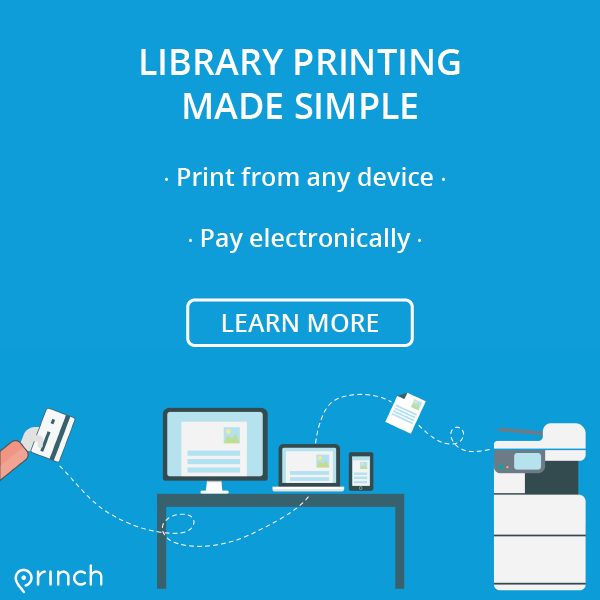The Internet of Things (IoT), a recent shift in technology that libraries’ and library staff should be familiar with as it may help improve the services, resources and experience that libraries’ can provide. In this week’s post Barbi Gardiner, an IT librarian, social media manager and founder of Library Tech talk, discusses all things IoT and libraries.
IoT in Libraries
Libraries are changing – that’s a fact. Today’s libraries look nothing like the libraries we grew up with 30 years ago…think card catalogs and cardigan wearing librarians shushing you for talking above a whisper.
Today’s libraries look more like community hubs and places full activity, innovation and technology. The reason for this change is simple. Libraries have had to adapt in order to maintain a relevant presence in our society.
Rather than be left behind, libraries have met the challenges associated with the adoption of new technologies head on and have adapted to these changes in order to provide the best services to patrons. In fact, it has become second nature to provide patrons with what they have come to expect in our technology driven world. At its core, libraries are having the same mission as they always have…to meet the needs of their communities.
Intelligent library management system consists of book renting, inventory, taging, and access control. @Hopeland_RFID, represented in Italy by @TechSigno, could offer whole #RFID solution. https://t.co/9agkyl9Pf3 #RFID #library #IoT #accesscontrol #filemanagement pic.twitter.com/hu9AQuQX5v
— Luca Defend (@madeinfriuli) November 5, 2019
One of the most recent changes in technology is the shift from the ‘Internet of Communication’ to the ‘Internet of Things’ or IoT. This exciting and emerging technology makes it possible to connect everyday objects, that are not themselves computers, by embedding sensors in them. This means that the IoT can include anything from factories, cars, appliances, toothbrushes, pacemakers and even lightbulbs.
The data collected from these sensors is then transferred over a network without requiring human interaction, all while having the networking capabilities that make it possible to communicate with each other, access Internet services and interact with people. (Techtarget 2018). In short, the IoT are simply objects or things where the infrastructure and technology involved are sensors, processors, cloud computing, and wireless connectivity.
It stands to reason then that this new paradigm is bound to impact library models, patron experiences, and our everyday lives. It will bring a myriad of changes to the library arena, most importantly the way the library connects and communicates with its patrons.
Some of the ways that the IoT is already utilized in libraries are technologies such as RFID (radio frequency identification) technology that allows for item identification and item security, machine 2 machine (M2M) communication, which are devices such as self-check kiosks or automated materials handling machines, and semantic search technologies that include metadata and discovery tools.
Other potential areas of IoT implementation for libraries:
- Improved access to collections and resources – IoT could make it possible to install RFID on all library shelves so patrons could quickly find where a book is located. Patrons could then be directed right to its location using a special app.
- Collection management and Inventory Control – Library material can be controlled by applying sensors on them. By connecting the sensor to the internet, the movements of each item can be tracked. This can provide real time data, thereby providing better inventory control as well as help patrons easily find the item they’re looking for. This could be done using a special app on their smartphones.
- Recommendation & Notification service- Smartphones could be detected in the library, via Wi-Fi or Bluetooth, and send targeted communications to patrons. For instance, IoT imbedded in patron library card will trigger a notification to readers who owe a fine to the library when they enter the building. This notification with a link directs patrons to the payment page. Iot could also be used to send a notification about a new fiction book in the library while the patron is looking for books in the fiction aisle.
- Mobile Technology and Location based services – track IoT devices to determine traffic patterns of patrons to improve space design or to better pinpoint popular library areas. Patrons could connect their phones to sensors and receive notifications to locate items from their favorites list. This data could help in optimizing staff, understand genre patterns and spot opportunities.
- Safety – By installing internet-connected fire sensors, disastrous fires can be dealt with more swiftly dealt and safely from outside the library
- Cost Savings & Appliances Monitoring – by using smart lighting that is controlled by the internet to sense when to have lights on or off or by implementing a smart energy system where energy consumption can be controlled according to need.
- Drones – Right now being tested by Amazon, there are implications here for libraries as well. It would become very easy to get materials to homebound patrons or people living in remote service areas.
- Automatically Survey Patrons – IoT sensors can know when patrons are leaving the library and automatically send a survey to the patron. Data can be collected to determine if the patron was satisfied with their experience.
- Direct patrons to special displays, programs and events – Most libraries, apart from storing books, organize events, such as storytelling, book discussion etc, and educational programs for children, teens and adults. With beacons deployed in the library, information about these events and special displays is just taps away.
This #drone delivers books to Indonesian children Via @wef #library #drones #UAV #IoT #digital #numerique #DigitalTransformation #TransfoNum #futureofwork #SmartCity #SmartCities #Education #innovation #indonesiehttps://t.co/QyK8VxClQ2 pic.twitter.com/tpgiNsVXGE
— GOGLIN (@GOGLINJF) May 14, 2019
Risks of IoT Implementation:
The rewards of this technology are many, but is also not without its risks. Libraries need to take into account a few serious considerations before implementing new IoT technologies.
- First is privacy and security of patron’s data as there is a possibility of sharing this data with third parties, which may lead to hacking.
- Secondly, the cost of investing in IoT technologies in terms of money, manpower and time.
- Thirdly, staff training in the usage of these new technologies.
Having no plan for staying on top of technology change guarantees the failure and irrelevance of libraries. Since we have no plans of letting that happen, libraries need to herald in these technology changes as they happen and be ready to implement them.

Barbi Gardiner
Website: https://librarytechtalk.com/
Twitter: @Librarytechtalk
Recent posts
Green Libraries: How Sustainable Design is Shaping the Future of Public Libraries
In this week's Princh Library Blog post, recurring guest writer Sam L. Bowman discusses an ever so important topic: sustainable design and [...]
Librarians Supporting Digital Literacy in the Community
In this week's Princh Library Blog, Nina Grant covers why digital literacy is important, the variety of ways in which librarians are supporting [...]





Leave A Comment